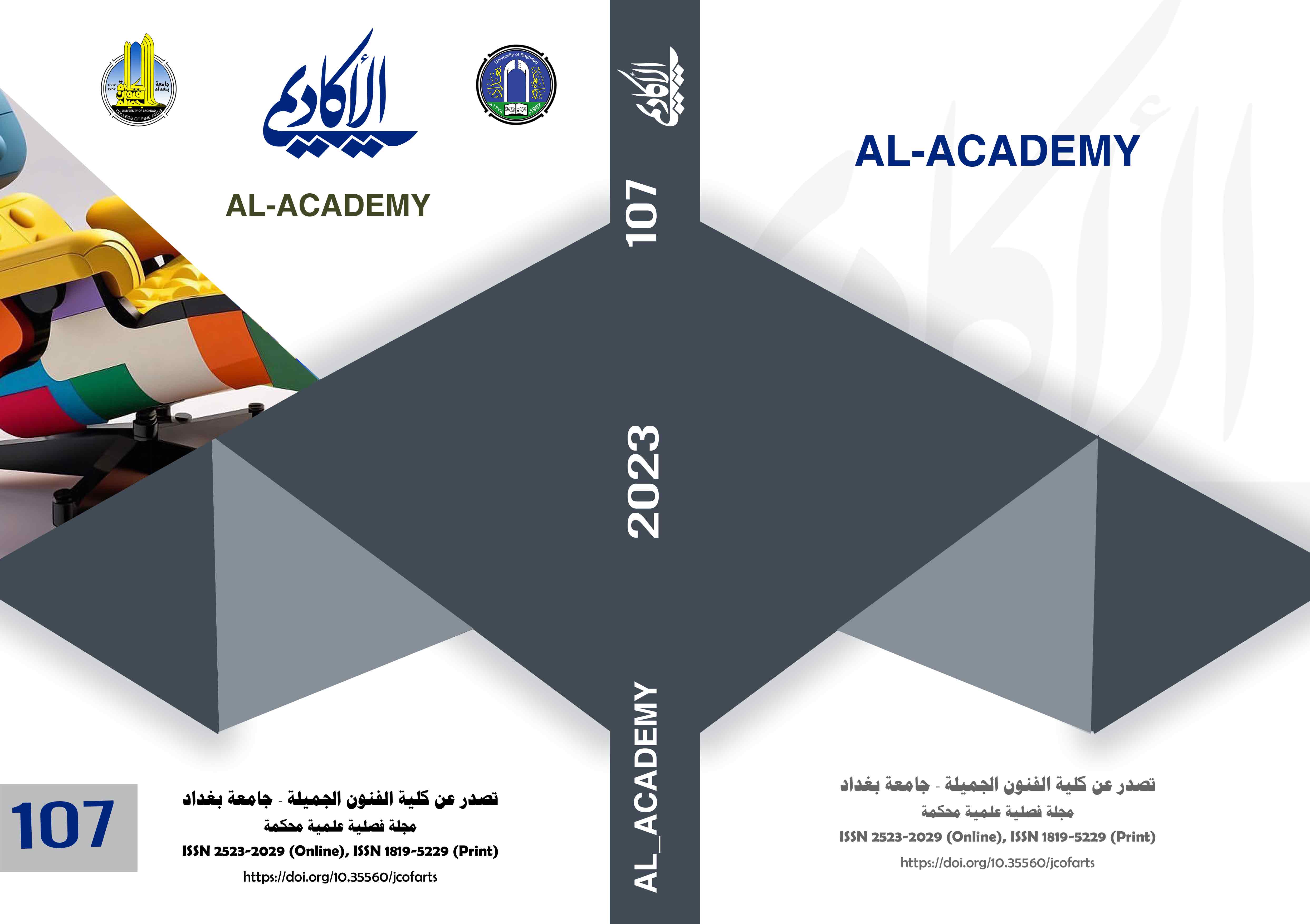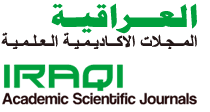Intellectual And Artistic Concepts of The Cultural Context And Their Impact On Contemporary Ceramic Sculpture
DOI:
https://doi.org/10.35560/jcofarts107/217-234Keywords:
The art, Context, The cultureAbstract
The current specialized research tagged (intellectual and artistic concepts of the cultural context and their impact on contemporary ceramic sculpture) paves the way for the emergence of the context in ceramics active in life, so that this relationship will indicate the development and presence of ceramics or not and the volume of its circulation in the joints of the culture of the Arab recipient. As a result, the researcher collected scientific materials to serve the subject of the research in four chapters: Chapter One (General Methodological Framework) To clarify the problem of the research, the importance of the research to achieve benefit in higher education and education for scholars and teachers, while the research aims to reveal the development of cultural contexts and their impact on the production and circulation of contemporary Arab ceramic art. They are the Arab countries, then the search terms were identified and defined. As for the second chapter (theoretical framework), it included three axes: the first: meaning Context. The second axis: thinkers' views of the context in language and linguistics. The third axis: the emergence of the context as representations in the artistic form, and in the third chapter (research procedures) the researcher reviewed the presence of ceramics in the Arab reality through the analysis of ceramic sculptural patterns. The researcher aims to select a sample that represents the boundaries of the research, its aim, and the framework of society. - Research tool: In order to achieve the goal of the research and to identify (the intellectual and artistic concepts of the cultural context and their impact on contemporary ceramic sculpture The researcher adopted the indicators concluded by the theoretical framework, and the researcher concluded in the fourth chapter a number of results: 1- The Arab audience formed a presence represented in the demand for works with peripheral contents in favor of types of cultural and artistic reception in addition to the factional and media. 2- Formal behavior in art. The contemporary Arab, the Arab recipient voluntarily accepts the forms within the ceramic sculptural work and its abbreviations brought by the postmodern culture other than what we have seen, as it simulates the forms through their symbols and meanings on the one hand and preserves their contents on the other hand. In addition to the conclusions, recommendations and proposals.
References
- Ibrahim Fathi. (2000). A glossary of literary terms. Cairo: Dar Al-Sharqiyat for publication and distribution.
- Ibrahim Mustafa. (no date). intermediate dictionary. Cairo: Dar Al-Da'wa for publishing.
- Ibn Manzoor. (2006). Arabes Tong. Cairo, Egypt: Dar Al-Hadith for printing and publishing.
- Father Louis Maalouf Al-Yousai. (Bit). Al-Munajjid in language and literature. Beirut: Catholic Press.
- The two prices. (no date). linguistics.
- The Holy Quran. (no date). Surat Al-Dukhan.
- Inoue et al. (2008). Semiotics origins, rules and history. Darmajdlawi.
- Andre Lalande (2008). Lalande Philosophical Encyclopedia. Lebanon, Beirut: Dar Oweidat for publishing and printing.
- Bouzawada Habib. (2018). Styles Magazine. Al-Ansaq International Scientific Journal, page 91.
- Paul Klee and Lita Hans. (2005). The science of signs. House of the Supreme Council of Culture.
- The camel of the courtesan of the carpenter. (2004). Studies in critical philosophy of history. Iraq / Baghdad: House of General Cultural Affairs.
- Jamil Saliba (no date). Philosophical Lexicon. Lebanon, Beirut: Lebanese Dar Btab.
- Hassan Nima Madi. (2015). Developing fine artistic taste. Iraq: Dar Al-Jawahiri for publication and distribution.
- Khaled Abboud Hamoudi Al-Sheikhly. (without a year). Consider context theory (a study between the ancients and the moderns). Iraq, Baghdad: Al-Mustansiriya University/Department of Arabic Language.
-Said Alloush. (2010). Dictionary of contemporary literary terms. Lebanon/Beirut: The Lebanese Book House.
- Saif Al-Din Al-Amdi. (no date). Linguistics between heritage and contemporary. Semantic search 95.
- Shaker Abdel Hamid. (2001). Aesthetic preference, a study in the psychology of artistic taste. Kuwait: National Council for Culture and Arts.
- Fida Hussein and Kholoud Badr Ghaith Muhammad Ali. (2009). Aesthetics through the ages. Jordan: Dar Al-Easar for publishing
- Abdel Fattah Mahmoud. (2005). The Qur'anic context and its impact on semantic weighting. Jordan/Amman: PhD thesis.
- Karima Muhammad Bshiwa. (2013). Flags of Art in Contemporary Western Thought. University Magazine, p. 88.
- Mark Jimenez. (2009). What aesthetic. Lebanon / Beirut.
- Muhammad bin Abi Bakr bin Abdul Qadir Al-Razi. (2017). Mukhtar Al-Sahah. Lebanon/Beirut: Dar Liban Library.
- Muhammad bin Makram Manzour Al-Afriqi. (2000). Arabes Tong. Beirut: Dar Al-Sader.
- Muhammad Jassim Al-Obaidi. (2009). Sculptural forms on the surfaces of Mesopotamian pottery and contemporary Iraqi ceramics. Iraq/Baghdad: House of Cultural Affairs.
- Murad Wahba (2007). Philosophical Lexicon. Egypt, Cairo: Dar Quba'a for publishing and distribution.
- Hisham Maafia (2010). Interpretation and Art of Hans-Georg Gadamer. Algeria: Dar Al Arabiya
ELMAHI, Z. (2022). Art as a therapy to relieve symptoms of Attention Deficit/Hyperactivity Disorder (ADHD), in children. Al-Academy, (106), 167–186. https://doi.org/10.35560/jcofarts106/167-186
bint Mohammad AlMutairi, S., & bint Ayed Alharbi , R. (2022). Inventory of Saudi youth trends towards choosing fashion accessories. Al-Academy, (106), 205–230. https://doi.org/10.35560/jcofarts106/205-230
Saleh Moraished, L., & Saleh Al-Saleh, M. (2022). The Relationship Between Using Diverse Materials to the Intellectual Context’s in the Art of Contemporary Ceramic. Al-Academy, (106), 253–270. https://doi.org/10.35560/jcofarts106/253-270
mohammed Alamri, M., & bint Mansour Abdul Aziz aljadid, M. (2022). Printmaking Techniques to Enable People with Visual Impairment to Taste Print Artworks. Al-Academy, (106), 297–318. https://doi.org/10.35560/jcofarts106/297-318
Gharsan Alshehri, H. . (2022). Role Of the Interactive Public Sculpture in Increasing Physical Activity . Al-Academy, (105), 57–80. https://doi.org/10.35560/jcofarts105/57-80
Ibrahim Alhulwah, N. ., Saud Alrasheed, E. ., & Almokhtar Lahyani, S. . (2022). The semiotics of the visual image of women in the discourse of empowerment, Saudi Arabia Kingdom as a model. Al-Academy, (103), 25–42. https://doi.org/10.35560/jcofarts103/25-42
Ahmad allaoui, L. . (2022). Textual thresholds and its Aesthetic in history: "Mamo Zain" by its author, the famous Kurdish poet Sheikh Ahmad Al-Khani, deceased (1118 AH / 707 AD), translated by Sheikh Dr. Muhammad Saeed Ramadan al-Bouti. Research on the connotation and manifestations of interconnection. Al-Academy, (103), 73–92. https://doi.org/10.35560/jcofarts103/73-92
mohamed Dammak, K. (2022). Transformations of the body from traditional expression to subjectivity : Marina Abramivic as a model. Al-Academy, (103), 149–164. https://doi.org/10.35560/jcofarts103/149-164
shafee, wafa H., & aboabat, A. A. (2021). Recycling waste toys to accessories suggested uniform for educational units in kindergarten stages. Al-Academy, (102), 63–80. https://doi.org/10.35560/jcofarts102/63-80
Ebraheem Mongy, Y. ., Amer Al-Hajri, S. ., & Al Mardhoof Al Saadi, N. . (2021). Inspiring heritage and symbols of local identity in contemporary Omani Graphic Art. Al-Academy, (102), 81–104. https://doi.org/10.35560/jcofarts102/81-104
Nasser AL Nahari , N. . (2021). The Role of Contemporary Interactive Art Works Economically and Culturally "An Analytical Study". Al-Academy, (102), 123–144. https://doi.org/10.35560/jcofarts102/123-144
Kalied Talib Alsamurai, A. . (2021). The communicative education of fine arts in the COVID-19 crisis and its manifestations in the modernization of the works of the Iraqi painter "Nabil Ali as a model". Al-Academy, (102), 207–222. https://doi.org/10.35560/jcofarts102/207-222
Daryanavard (al-ghaisi), Z., Balavi, R., & M. Bataineh, A. (2021). The Communicative Functions in The Speech of The UAE National Anthem in The Light of The Eloquence of The Audience. Al-Academy, (101), 145–156. https://doi.org/10.35560/jcofarts101/145-156
Abdullah Al-Qudairi, T. (2021). Designing Clothes that Meet the Functional and Aesthetic Needs of Children with Hip Dislocation. Al-Academy, (101), 157–184. https://doi.org/10.35560/jcofarts101/157-184
Abdulaziz Alfadda, A. (2021). Utilization of Design Principles of Nature in Innovating Contemporary Metal Products. Al-Academy, (101), 203–226. https://doi.org/10.35560/jcofarts101/203-226
Daryanavard, Z., Balavi, R., & Khezri, A. (2021). Semantic functions of repetitive synthesis in Adnan al-Sayegh’s poetry. Al-Academy, (100), 233–246. https://doi.org/10.35560/jcofarts100/233-246
Hassan Abu Hasna, R. (2021). The Utilization of Arabic Calligraphy to Inspire Modern Arabic Type Designs. Al-Academy, (100), 277–304. https://doi.org/10.35560/jcofarts100/277-304
Aldaawani, R. F. (2021). The semiotic of the Islamic blazon - a related analytical study between the Islamic blazon and its publicity message. Al-Academy, (100), 319–336. https://doi.org/10.35560/jcofarts100/319-336
Wafa Hassan, S., & Marram Zaid, A.-H. (2021). Sustainability by recycling palm waste in designing women’s belts. Al-Academy, (100), 337–356. https://doi.org/10.35560/jcofarts100/337-356
Kazem Odeh, R., & Khalaf Hussain, S. (2021). The effectiveness of media communication and its problems in the contemporary theatrical presentation. Al-Academy, (99), 155–168. https://doi.org/10.35560/jcofarts99/155-168
Saud Al-Hazza, H. (2021). Study of the participation of Saudi women in official visual arts exhibitions "Contemporary Saudi Art Exhibition as an Example". Al-Academy, (99), 311–328. https://doi.org/10.35560/jcofarts99/311-328
Ali Ahmed Abdel Rahman, R. (2021). Making use of economical design techniques and materials in implementing cosmetic supplements to the interior spaces of the dwelling. Al-Academy, (99), 329–348. https://doi.org/10.35560/jcofarts99/329-348
Al Saadi, N. (2021). Variables related to the performance styles of batik art to achieve linear tactile effects in the printmaking. Al-Academy, (99), 349–364. https://doi.org/10.35560/jcofarts99/349-364
Saad Algarni, M. (2021). Virtual Art Exhibitions In Times Of The Corona Pandemic. Al-Academy, (99), 441–480. https://doi.org/10.35560/jcofarts99/441-480
Abduljabbar AlEssa, A. (2020). Simulation As One Of The Tools Of Visual Thinking And Its Effect On Developing Drawing And Design Skills To Produce Innovative Artworks. Al-Academy, (98), 235–254. https://doi.org/10.35560/jcofarts98/235-254
Mohammed Al-Mutairi, S., Yousef Altwaijri, B., Yousef Al-Ali, R., & Abdul Hakim Almoqrin, S. (2020). Designing an E-marketing Website for Sustainable Fashion. Al-Academy, (98), 271–286. https://doi.org/10.35560/jcofarts98/271-286
A.A. FEDA, L. (2020). GIRL’S TRADITIONA COSTUME IN MAKKAH AL MUKARRAMAH _ KINGDOM OF SAUDI ARABIA”. Al-Academy, (98), 305–324. https://doi.org/10.35560/jcofarts98/305-324
Abdulhafeez, N. (2020). Novel Coronavirus Pandemic as it is Expressed by Children in Their Drawings On-line: An Analytical Study. Al-Academy, (98), 413–434. https://doi.org/10.35560/jcofarts98/413-434
Almamari, B. M. (2020). Appearance and Decay of Split-brain Theory to Explain Human Artistic Activity: A Historical Review. Al-Academy, (97), 261–270. https://doi.org/10.35560/jcofarts97/261-270
Abdulhafeez, N. (2020). The Philosophy of Beauty and Aesthetic Tasting in the Story of Yusuf, peace be upon him, with the Al-Azeez’s Wife in light of the sayings of Ancient Philosophers and Modernists. Al-Academy, (97), 241–260. https://doi.org/10.35560/jcofarts97/241-260
O Alzahrani, M. (2020). The Image of Women in Arab Media Advertisements. Al-Academy, (97), 299–320. https://doi.org/10.35560/jcofarts97/299-320
Abdulghaffar Feda, L. (2020). Recycling evening dresses into modern dresses with traditional features. Al-Academy, (97), 321–342. https://doi.org/10.35560/jcofarts97/321-342
Saud Alrasheed, E. (2020). Digitization is a contemporary reality and its importance in the Saudi plastic arts. Al-Academy, (96), 213–228. https://doi.org/10.35560/jcofarts96/213-228
Mohammed Alamri, M. (2020). Inspiration Of Typed Paintings From Folk Architecture In Asir Region. Al-Academy, (96), 229–250. https://doi.org/10.35560/jcofarts96/229-250
Murshed Alharbi, M., Alahmad, H., & Alsenan, M. (2020). Saudi society’s trends towards visiting museums and art galleries. Al-Academy, (96), 251–272. https://doi.org/10.35560/jcofarts96/251-272
kadim oda, russil, & fuad fadhel, L. (2020). Techniques of Acting Performance in Fantasy Theatrical Show. Al-Academy, (95), 5–18. https://doi.org/10.35560/jcofarts95/5-18
Mohammed taleb al dweik, S., abu taleb, S., & saber, M. (2020). The Role of the Passive Conditioning in Achieving Thermal Comfort in Temporary Hotel Units. Al-Academy, (95), 243–272. https://doi.org/10.35560/jcofarts95/243-272
Ibrahim Bin Hamdan, N. (2019). Creativity in the Draping on the mannequin of Young Girls Victorian Fashion between 1860-1890. Al-Academy, (94), 73–96. https://doi.org/10.35560/jcofarts94/73-96
Nassar Alajaji, T., & Abdulazez Almogren, H. (2019). The Effect of The Illustration Program on Fashion Design Inspired by Historical Costumes:. Al-Academy, (94), 97–114. https://doi.org/10.35560/jcofarts94/97-114
Nassar Alajaji, T., & Mohammed Alfulaij, W. (2019). Revival of the Heritage Using Porcelain Units Inspired by Traditional Sadou Decoration and Kufic Calligraphy in Fashion Design. Al-Academy, (92), 253–270. https://doi.org/10.35560/jcofarts92/253-270
Nawi, K. (2019). Time in the Cinema.The Two Films (The Knife and The Deceived) -A Model. Al-Academy, (91), 49–64. https://doi.org/10.35560/jcofarts91/49-64
alsayed Mustafa jawad ahmed, B. (2016). The Instagram from a media tool to a marketing tool. Al-Academy, (74), 195–212. https://doi.org/10.35560/jcofarts74/195-212
Khaled Taleb Al Samurai, A. (2018). The educational means used by teachers of art education in primary schools. Al-Academy, (89), 229–240. https://doi.org/10.35560/jcofarts89/229-240
Jassem Mohammed, N., & Taha yaseen, E. (2017). Structural Systems In The Design Of World Magazine Covers. Al-Academy, (86), 149–164. https://doi.org/10.35560/jcofarts86/149-164
al-Khalidi, A. S. (2017). The reality of interior design of Sharjah mosques and the possibility of development - selected models. Al-Academy, (83), 247–267. https://doi.org/10.35560/jcofarts83/247-267
kadim oda, R. (2016). Actor performance features in the types of theatrical silent. Al-Academy, (79), 225–238. https://doi.org/10.35560/jcofarts79/225-238
kadim oda, R. (2016). Indicative coding of the actor’s performance in the Iraqi theater show. Al-Academy, (77), 63–74. https://doi.org/10.35560/jcofarts77/63-74
Allawi Salal, A. ., & Kadim oda, russil. (2022). Actor’s skills in pantomime theater performances. Al-Academy, (105), 121–132. https://doi.org/10.35560/jcofarts105/121-132
kadim oda, russil, & fuad fadhel, L. (2020). Techniques of Acting Performance in Fantasy Theatrical Show. Al-Academy, (95), 5–18. https://doi.org/10.35560/jcofarts95/5-18
Kadim oda, russil, & Khalaf Hussain, S. (2021). The effectiveness of media communication and its problems in the contemporary theatrical presentation. Al-Academy, (99), 155–168. https://doi.org/10.35560/jcofarts99/155-168
Downloads
Published
Issue
Section
License
Copyright (c) 2023 rasool jabor mahmoud, Ali Hussein Alwan

This work is licensed under a Creative Commons Attribution 4.0 International License.













